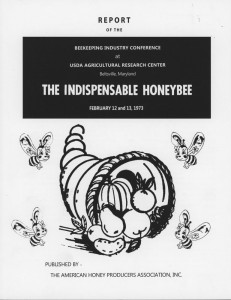by G. Splevin
In the Nov. 2015 Bee Culture magazine I wrote of the 1973 report, “The Indispensable Honey Bee.” This report is a compilation of presentations from a 1973 American Honey Producers Association conference in Beltsville, Maryland. I was keeping bees in 1973, and when I saw a reprint of “The Indispensable Honey Bee” I was intrigued to review the past and learn what has changed in 41 years. At age 81 I still attend the Eastern Apiculture Society Conferences, my state beekeeping conference, and participate in my local beekeeping club. I am continuing to learn, but I wonder if the beekeeping industry is learning.

Compared to the 1973 report regarding the issues with honey bees today: no learning has occurred. The beekeepers in this 1973 report presented grave concerns for honey bees due to pesticides and loss of habitat starting in 1968. It took five years for a national conference to bring the issue to the national discourse.
What happened in those intervening years – 41 years? As the report from 1973 clarifies not much has changed in 41 years. The bee industry has continued to state they are on their last legs, and the industry is weak. While many of the commercial beekeepers from 1973 are still commercial beekeepers, or their sons have taken on the business, their sons are now aging, and their sons are highly skeptical of the long-term viability of the industry.
What has been accomplished in 41 years, and what has not, and why not? Why are the issues from 1973 the same issues beekeepers experience today? While the bee industry has exclaimed the bees are disappearing and so are beekeepers: neither has come true in 1973 or today.
Agriculture has expanded, and still beekeepers breed enough bees to pollinate the crops. Granted, as a business model suffering the loss of your “employees” (working honey bees) 30-60% losses each season is not sustainable: still beekeepers have done it.
Some though have sold their businesses. The majority of beekeepers have suffered in silence, blaming themselves, yet knowing it is pesticide exposure along with Varroa, disease, and no forage, or pesticide contaminated forage killing their bees. Even if these crop pollinating beekeepers have a contract with a grower protecting their bees while pollinating, none of the beekeepers will utilize the legal contract when its guidelines are breached, and bees are killed.
From 1973 to today beekeepers are not believed: that their bees are dying, that beekeepers are suffering financially, and that their signature (and the farmer’s) on a contract meant to protect their bees has no value. Therefore, beekeepers are not taken seriously, their industry is not viewed as a united industry, and when a contract is broken, and there are no ramifications, the contract has no value, therefore bees (and the beekeeper) have no value.
This is the world beekeepers have helped to create for themselves. The effect of the Varroa destructor mite and systemic pesticides are new contributing factors since 1973. These two factors have greatly changed the landscape for bees and beekeeping, but it was two things added to a list of already detrimental effects upon bees that has not changed since the 1973 report.
Richard L. Adee, then Vice President of American Honey Producers Association, stated in his report at this conference:
“The decline of beekeeping in the U.S. can be attributed to three specific problems – poor honey prices, pesticides, and limited bee pasture. The order in which the problems are rated will depend on where the beekeeper lives in the U.S. In some areas, it may just be one problem affecting the beekeeper and in other areas it might be a combination of all three.”1

Richard Adee
“To meet the challenges of beekeeping today, many beekeepers have turned to migrating with their bee colonies. This means that the beekeeper moves his bees South in the Fall and back again in the Spring. By doing this, the beekeeper can cut down on the amount of honey stores needed to Winter a colony and he also can replace colonies lost the past season due to queen failure, pesticides, etc. Some beekeepers also harvest two crops of honey from their bees. One in the South and another one in the north.”2
The President of New Mexico Beekeepers Association, Berna Johnston, spoke of the loss of the “various kinds of flowers which make up what we call bee pasture.”3 He acknowledged the growth of the U.S. from 1873 to 1973 as having caused some of the loss due to urbanization and highway development. “But much pasture has been lost needlessly through short-sightedness and selfishness”…“The changing methods of farming have contributed greatly to the loss of bee pasture.”4 The business model of beekeeping slowly changed from earned income from honey sales to earned income from crop pollination. But at what cost to both earned revenue streams for beekeepers?

Berna Johnson
“If the future pollinating requirements of this country are to be met, the beekeeping industry must continue to have access to the latest advances in technology, science, and economics.”5 wrote Richard L. Adee in his report. That was true in 1973, and is still true today.
Beekeepers need funding for the “technology, science, and economic” research, analysis, and product development for bees, honey, beekeeping management, and more. This funding needs to be supported at the local, state, and federal levels. However, once beekeepers have the technology and the research, they need to implement the technology appropriately. There are no short-cuts. Short-cuts, and cost-cutting just kills bees. From 1973 to today beekeepers continue to cut costs and short-cut their beekeeping management, and wonder why their bees are dwindling and dying.
Beekeeping leaders in 1973 were asking “someone” to do something, “someone” to improve the world in which their bees live, and the work of beekeepers. In 1973 and today, beekeepers have yet to realize that “someone,” is them. The “someone” needs to be all of them, united for the common cause of their honey bees and beekeeping.
Beekeeping leaders at the local, state, and national level need to be leaders, and work to protect our bees. In 1973 and today beekeeping leaders talk of “protecting honey bees and the ecosystem” for our grandchildren. Those beekeepers’ grandchildren are now working bees, and nothing has changed.
The beekeepers in 1973 waited for “someone” to do something, and here we are still stuck in 1973: pesticides, loss of habitat, migrating with bees, the price of honey, the high cost of managing bees through all of these issues makes beekeeping difficult.
I am 81. I am old and yet, I am still learning. When will the bee industry leadership begin learning? When will beekeeping leadership work to protect our bees now, not wait for another generation of “grandchildren?” When will the beekeeping leaders become “someone” and advocate for beekeeping, beekeepers, honey, and honey bees? Beekeeping leaders need to come together on the issues affecting our bees. These are the same issues from 1973: forage, pesticides, pests, and bee diseases. Beekeepers need to unite under the common cause of improving honey bee health.
Diversity is wonderful, and reflective of any industry, but diversity of the health issues affecting bees should be a part of every bee club and association: forage, pests, pesticides, and diseases. These four issues have been the focus since 1973 (earlier than that, but I am referencing the 1973 report, so that year is used for comparison). These four issues reflect the greater good for our bees. This must be the focus of all beekeepers. Nothing else! The health of honey bees as they are impacted by forage, pesticides, pests, and bee diseases must be the uniting force bringing beekeepers together.
Nothing has changed for our bees since 1973. Beekeepers must be the “someone” making the change: no one else will do it for us.
The next issue will feature the USDA, and researchers’ contributions at the 1973 conference. Stay tuned for further discussion on beekeeping in 1973 and 2015 from this “curious guy.” Read the actual report, The Indispensable Honey Bee, Feb. 12-13, 1973, available through Bee Culture magazine.
1Report of the Beekeeping Industry Conference at USDA Agricultural Research Center, Beltsville, Maryland, “The Indispensable Honeybee,” February 12 and 13, 1973, published by the American Honey Producers Association, Inc., page 118
2Ibid, page 120
3Ibid, page 53
4Ibid., page 53
5Ibid, page 121








